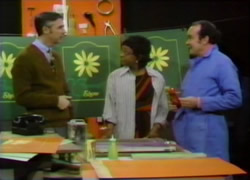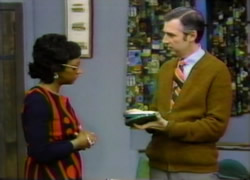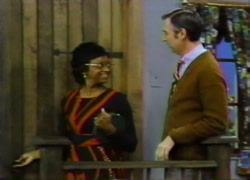I Learned From Mister Rogers
 Episode 1386 of Mister Rogers' Neighborhood [May 13, 1974] features a visit to Bob Trow's workshop where Mr. Trow is demonstrating the art of screenprinting. Helping him in his workshop that day is Marion Young. Later in the episode, Mrs. Young stops by Mister Rogers' house to show a short film about a kindergarten class. Throughout the program, Mrs. Young's message is clear -- not only do children learn from teachers, but teachers learn from children, as well. Additionally, Mrs. Young set out to help ease the anxieties and worries that young children may experience as they start school.
Episode 1386 of Mister Rogers' Neighborhood [May 13, 1974] features a visit to Bob Trow's workshop where Mr. Trow is demonstrating the art of screenprinting. Helping him in his workshop that day is Marion Young. Later in the episode, Mrs. Young stops by Mister Rogers' house to show a short film about a kindergarten class. Throughout the program, Mrs. Young's message is clear -- not only do children learn from teachers, but teachers learn from children, as well. Additionally, Mrs. Young set out to help ease the anxieties and worries that young children may experience as they start school.
I recently had the wonderful pleasure of speaking with Mrs. Young about her appearance on Mister Rogers' Neighborhood. Today, at the age of 76, Mrs. Young holds dearly her memories of Fred Rogers and his work with children. What follows is a complete transcript of our brief but touching conversation. Many thanks to you, Mrs. Young, for generously sharing your time and your story.
Interview with Marion Young – November 10, 2010
NEIGHBORHOOD ARCHIVE: Describe what led to your time on the show.
MARION YOUNG: My mother-in-law, Louise Young, was a caterer and she usually catered for Mister Rogers’ dinner parties. So I went with her several times and I got to know Mister Rogers and his wife and the children. And when I wanted to go into a child development program, I had to have someone recommend me. So Mister Rogers wrote a letter of recommendation for me to get into the program.
Fortunately when I finished, I was sent to Arsenal Family and Children’s Center and that’s where Mister Rogers went often because Dr. Margaret McFarland was his mentor [Dr. McFarland was an Arsenal director]. So I was at Arsenal for, it had to be about twenty years that I was there – and I would see Mister Rogers every day. I worked with the children and I also worked with the students from the University of Pittsburgh because that’s where they came – that’s where the students came to do their student work and I was always given a student to help. Dr. McFarland, well, anybody would go into the observation booth and watch us interact with the children.
 So Dr. McFarland had recommended me to Mister Rogers to go on his show because I had already been in two films at Arsenal. One was It’s All Mine – and that was helping people to understand the separation process that the children go through. And then there was another film about play and how children learn from play. So after I did those two films, they were shown to the students and Dr. McFarland. After that, she felt like I did so well on those films that she recommended me to go on Mister Rogers’ show.
So Dr. McFarland had recommended me to Mister Rogers to go on his show because I had already been in two films at Arsenal. One was It’s All Mine – and that was helping people to understand the separation process that the children go through. And then there was another film about play and how children learn from play. So after I did those two films, they were shown to the students and Dr. McFarland. After that, she felt like I did so well on those films that she recommended me to go on Mister Rogers’ show.
So I went one time and that’s when I did the take that you gave my daughter [I had provided Mrs. Young's daughter with a copy of the episode featuring her mother] to help children to understand that children learn from teachers and also to reduce their anxiety about the first day of school. I could have appeared on Mister Rogers’ show more than once, but for some reason I was too nervous. I often think about how when I made the films at Arsenal I wasn’t as nervous, but when I went on Mister Rogers’ show, I said, “Oh, I don’t think I want to do this again.” So I only did it the one time.
NA: Was Mister Rogers’ program a show that your own children watched?
MY: Yes. My daughter that had talked to you, she and my son. They both watched Mister Rogers. So everybody had a really, really deep appreciation for Mister Rogers. Singing his songs. We still do.
NA: I imagine being on the set and filming the show must have been somewhat surreal then.
MY: Yes. And now when I see Mister Rogers all over the world, everywhere he has been, people all over the world have watched his shows. Then when I would watch Eddie Murphy and he would imitate Mister Rogers, I began to realize – well, I always knew that Mister Rogers was a very unique person. But the older I got, the more I realized and appreciated the work that he did. Because, like I said, it seems like everybody knows of Mister Rogers.
 NA: Could you describe a little bit about Fred Rogers and the times that you interacted with him? What was he like as a person?
NA: Could you describe a little bit about Fred Rogers and the times that you interacted with him? What was he like as a person?
MY: He was very easy-going. Very soft-spoken. And there was no reason to be nervous with him. I think it was just me being filmed and knowing that I was going to be on the air. I think that’s what it was. But Mister Rogers was a very, very, very kind and gentle person.
In fact, when I went there for rehearsal the first day, I knocked on the door and he was to say, “Oh, it’s Mrs. Young.” But I missed my cue the first time he came and I wasn’t there and he said, “Mrs. Young? Where are you?” This was just typical of him because he was really a nice, easy-going person.
NA: What was involved with your appearance on the show? Was it a scripted performance?
MY: Well, he told me what he wanted me to do. He wanted me to say the lines he had given me. But somehow or another, I wasn’t able to remember the lines exactly when I got on the show. So I was in Trow’s workshop and we were doing silk screening and we were teaching children how to silk screen. And that was about the gist of it. Just letting children know that teachers learn from children because… I’m not sure if there were children there but it was to let children know that teachers do learn from children. And to also reduce their anxiety about school, I was to let them know that there would be a place for their things and a place for them to hang up their coats. From that time I thought I could have said a lot of things but things didn’t come to mind at that time. I could have said different things to keep children from being anxious about school.
NA: If there was one thing that you could say that you learned from knowing Fred Rogers, what would it be?
MY: I think it’s being very honest – very honest with children. And being very soft-spoken and trying to understand them. And more or less speak to them in their own language to make children feel comfortable. And that’s the way Dr. McFarland was. She was a very, very good person. He learned a lot from Dr. McFarland. We all did. I learned from her and I also learned from Mister Rogers.
